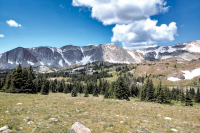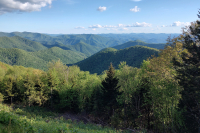Build it and they will come
 Back in spring of 2011 I wrote about a wetlands restoration project at Lake Junaluska - www.smokymountain news.com/archives/item/3686-a-perfect-fit. Candace Stimson, in order to fulfill her Low Impact Development degree at Haywood Community College, unearthed Suzy’s Branch behind Jones Cafeteria and created about 100 feet of free-flowing stream and wetlands.
Back in spring of 2011 I wrote about a wetlands restoration project at Lake Junaluska - www.smokymountain news.com/archives/item/3686-a-perfect-fit. Candace Stimson, in order to fulfill her Low Impact Development degree at Haywood Community College, unearthed Suzy’s Branch behind Jones Cafeteria and created about 100 feet of free-flowing stream and wetlands.
The sounds of silence
This morning when I had coffee on my deck, I did not hear the hooded warbler that nests in the tangles in the young woods below my yard. I did not hear a northern parula singing from the tops of the tulip poplars. There was no buzzy black-throated blue song emanating from the rhododendrons along the little creek. I did not hear a single raspy “chickbuuurrrr” anywhere in the forest. There were no schizoid red-eyed vireos talking to themselves as they bounced from tree to tree, and no wood thrushes graced the early morning with their sweet flute song.
Rose-breasted grosbeaks on the move through the Smokies
 Migrating rose-breasted grosbeaks have been appearing at feeders throughout the Smokies region in recent weeks.
Migrating rose-breasted grosbeaks have been appearing at feeders throughout the Smokies region in recent weeks.
Those birds that migrate hundreds of miles across the Gulf of Mexico from Central and South America to nest in the United States and Canada are known as the neotropical migrants. Each spring a number of these migrants breed here in the mountains of Western North Carolina. No other bird in our avifauna is more striking in appearance.
It’s bird-tember!
 Those quiet mornings are starting to set in. Yesterday, the only morning chorister in full song, in my yard was a Carolina wren. My summer-hooded warbler could be heard occasionally, but it was like he was humming to himself. Immature towhees were shouting out “drink!” from the tangles and there was an assortment of humming bird squeaks and chickadee and titmouse grousing but the rousing morning chorus that has been with us since early May is gone.
Those quiet mornings are starting to set in. Yesterday, the only morning chorister in full song, in my yard was a Carolina wren. My summer-hooded warbler could be heard occasionally, but it was like he was humming to himself. Immature towhees were shouting out “drink!” from the tangles and there was an assortment of humming bird squeaks and chickadee and titmouse grousing but the rousing morning chorus that has been with us since early May is gone.
Stoked for storks
 As we started over the bridge on the Isle of Palms Connector, I noticed a line of large black and white birds through the pine trees. “Gourd heads,” I must have said out loud, because my wife said, “What?”
As we started over the bridge on the Isle of Palms Connector, I noticed a line of large black and white birds through the pine trees. “Gourd heads,” I must have said out loud, because my wife said, “What?”
“Wood storks,” I said, pointing to the undulating line of five or six wood storks, alternately flapping and gliding across the marsh at low tide.
Famous NYC offspring
 New York City is big, bustling and in July – hot, but there are always entertaining and even educational ways to escape the heat. The planets aligned just right giving both Denise and me the entire July Fourth week off.
New York City is big, bustling and in July – hot, but there are always entertaining and even educational ways to escape the heat. The planets aligned just right giving both Denise and me the entire July Fourth week off.
We donned our tourist attitudes and headed north for a visit with Denise’s sister in Eastampton, New Jersey and a short train ride and a day in the Big Apple with Izzy (10) and Maddie (6).
The feisty, showy and talented grosbeak
 A couple of weeks ago I wrote about scarlet tanagers, a showy rather common species I assumed most were familiar with. But at least 10 readers emailed or otherwise contacted me to say they had located and seen their first scarlet tanager because I had described their vocalizations. In that regard, let’s see what we can do with rose-breasted grosbeaks.
A couple of weeks ago I wrote about scarlet tanagers, a showy rather common species I assumed most were familiar with. But at least 10 readers emailed or otherwise contacted me to say they had located and seen their first scarlet tanager because I had described their vocalizations. In that regard, let’s see what we can do with rose-breasted grosbeaks.
Its a scarlet tanager kind of year
“The scarlet tanager flies through the green foliage as if it would ignite the leaves.
You can hardly believe that a living creature can wear such colors.”
— Henry David Thoreau
This seems to be a scarlet tanager kind of year. I’ve been seeing and hearing them at my house, along the Blue Ridge Parkway, and in the Great Smokies. No bird in our region is more striking. Jet black wings on a trim red almost luminescent body, the male is impossible to overlook. And it’s easy to recognize by both song and call.
I almost never encounter the summer tanager (whose entire body is rosy red) in Western North Carolina, but the scarlet tanager is encountered every year — to a greater or lesser extent — during the breeding season (mid-April to mid-October) in mature woodlands (especially slopes with pine and oak) between 2,000 and 5,000 feet in elevation. The bird winters in northwestern South America, where it enjoys the company of various tropical tanagers that do not migrate.
Keep in mind that the female doesn’t resemble her mate except in shape. She is olive-green or yellow-orange in color. Also keep in mind there is a variant form (morph) of the male tanager that is orange rather than scarlet in color. I suspect this variant is the result of something peculiar in its diet. My first and only encounter with an orange scarlet tananger was in the Lake Junaluska area several years ago.
The call note used by both the male and female is a distinctive “chip-burr … chip-burr.” The male’s song is not pretty. He sounds like a robin with a sore throat; that is, the notes in the song are hoarse and raspy. When gathering nesting material, the female sometimes sings a shorter “whisper” song in response to the male’s louder song.
Males in adjacent territories often engage in combative counter-singing and will, as a last resort, go beak-to-beak. On our property, a creek sometimes serves as a boundary — the line drawn in the sand, as it were. The males sing defiantly at one another across the water and sometimes make forays into enemy territory. Meanwhile, the female is busy incubating her eggs. When not squabbling with a nearby male, her mate brings food.
George Ellison wrote the biographical introductions for the reissues of two Appalachian classics: Horace Kephart’s Our Southern Highlanders and James Mooney’s History, Myths, and Sacred Formulas of the Cherokees. In June 2005, a selection of his Back Then columns was published by The History Press in Charleston as Mountain Passages: Natural and Cultural History of Western North Carolina and the Great Smoky Mountains. Readers can contact him at P.O. Box 1262, Bryson City, N.C., 28713, or at This email address is being protected from spambots. You need JavaScript enabled to view it..
Artful birding
I had to take my shoes off to get there, but I believe last Saturday (April 28) was the 13th annual Birding for the Arts. BFA is part of the Haywood County Arts Council’s “Fund Party Series” – entertaining, fun events that help fund the Arts Council and all the wonderful things they provide for our community. You can learn more about the Arts Council and their Fund Party Series plus much more at www.haywoodarts.org.
Gracious and enthusiastic hosts for this annual event are Joe Sam and/or Kate Queen. We meet at 8 a.m. at the Performing Arts Center to get a quick overview of the day and begin our birding. This is where we pad our list. If you’re looking for numbers on a daily bird trip, you have to include the common “yard birds” like European starling, mockingbird, robin, house sparrow, etc.
After the Performing Arts Center we set out for Lake Junaluska, then to the Blue Ridge Parkway, where we dine at the Waynesville Overlook before heading on up and then descending down either N.C. highway 215 or U.S. 276, through the forests to the farmlands of Bethel and back to the Performing Arts Center.
Guests are free, of course, to bird for as long or little as they wish. The whole day generally lasts till around 5 or 5:30 p.m., and we wind up with around 80 species. We keep an “official” tally and, of course, not everyone sees and or hears every bird recorded but we do our best to get visuals where we can and point out songs and or calls. We had 13 participants meet at the Performing Arts Center this spring and six plus Kate and I stuck it out for the whole day, recording 83 species.
The thing about birding one day during spring migration is there are always hits and misses. Last Friday, there were Cape May and palm warblers at Lake Junaluska but neither was present on Saturday. However, great looks at a black-crowned night heron at the new wetlands and a common loon in full breeding plumage fishing just 50 feet or so from the shore provided a couple of good hits to make up for those misses. We also got outstanding looks at an osprey perched near Highway 19.
The Parkway started out a little slow but the Waynesville Overlook was productive as usual. We lunched with rose-breasted grosbeaks, scarlet tanagers, blue-headed and red-eyed vireos, chestnut-sided warblers and blackburnian warblers.
We didn’t see any peregrines at Devil’s Courthouse, but we did get up close and personal looks at a pair of Canada warblers. We were also able to list golden-crowned kinglets from there, as we heard them but couldn’t get any looks.
We were kinda stuck in the high 70s species wise, but our last stop at a wet area near Bethel gave us the boost we needed by adding yellow warbler, blue-gray gnatcatcher, great blue heron, blue-winged teal, wood duck and belted kingfisher.
Birding for the Arts is a great low-key yet high quality birding experience for novice and experienced birders. And if you can’t spend an entire day – the morning, through lunch at the Waynesville Overlook, is well worth the ticket price. I believe we tallied 61 species by the time lunch was over last Saturday.
And there are more birding opportunities available in Haywood County. If you’re interested in linking up with birders in the area try the Carolina Field Birders at http://groups.yahoo.com/group/CFBlist/ or contact Connie Wulkowicz at This email address is being protected from spambots. You need JavaScript enabled to view it.. There is also a new Audubon Chapter in the area, Great Smoky Mountains Audubon at http://gsmas.com/Site/Welcome.html.
And please support your local arts council and join us for another fund day, next year at the 14th annual Birding for the Arts.
(Don Hendershot is a writer and naturalist. He can be reached a This email address is being protected from spambots. You need JavaScript enabled to view it..)
A Conference of Birds
At Wild South’s recent “Green Tie Gala,” friend, writer, poet and publisher Thomas Rain Crowe, with a knowing wink, slipped a slim beautifully bound chapbook into my hands. I cracked it open immediately upon arriving home and read the first poem “Antidote to Narcissus:”
I’ve heard the great blue heron
Cannot see its own reflection
Cast from the water’s surface —
a gift that it may never lose a fish
in the image of a perfect eye
or fail to see a frog amid
such slate feathers shed
from a rookery on high.
If only we could fade that way
Into the mist of rivers,
Into rhododendron shade;
If only we could be so beautiful
And not know a thing about it.
I perused some of the 14 other titles — “Parable of the Flycatcher,” “The Nuthatch,” “Hawks: A Homily,” “Parable of the Wren,” — then closed the book and left it on the kitchen counter near the coffee pot to wait for dawn.
Next morning with coffee and book in hand, I sat out on the deck where towhees were conferring with chickadees and cardinals conversed with wrens to read the rest of A Conference of Birds. The book is Christopher Martin’s first book of poetry. Martin lives in the Georgia piedmont near Kennesaw Mountain with his wife and two children and is pursuing a Master of Arts in Professional Writing at Kennesaw State University. He is the editor of the online literary magazine “Flycatcher: A Journal of Native Imagination” and his work has appeared or is forthcoming in “Shambhala Sun,” “Loose Change Magazine,” “New Southerner,” “Buddhist Poetry Review,” and others. Martin is working on “Native Moments: An Ecology of Fatherhood,” a collection of essays and has contributed to the “Elevate/Art Above Underground” project in Atlanta.
Nature has called to poets ever since there have been poets. It spurred ancient Greek poet Theocritus to pen his idylls and has been muse for every epoch of literary history. And poets like Wordsworth, Coleridge, Burns and Blake penned lines in the voice of their time and passed the baton on to Emerson, Thoreau, and others then followed by Frost, who knew how to turn a common phrase, and today in voices of their own poets like Oliver, and, closer to home, Ray and Crowe and others with open eyes, open ears and open hearts speak to us in clear voices. The speak not only about the world around us but how the world around us and the world within us is only one world.
Martin has a strong, clear and compelling voice to add — from “Hawks: A Homily” “… But I wonder how one can speak/of angels, whose wings we have not seen,/when red-tail hawks still fly over interstates/on black-dappled, rust, red, white-brushed,/creation-colored wings,/and nest on rooftops/angels never would.”
And he understands how those worlds are intertwined, “… My child cannot see that far,/I’m sure, cannot see the falling,/dancing flares of dark purple,/the swallows that follow dragonflies./Before my son, I’m not sure/I would have seen them, either,/not sure I would have opened my eyes.” From “Watching Purple Martins.”
I found Martin’s poetry tight and timely; what poetry is about — in the now, while brushing eternity. I know you can purchase A Conference of Birds here - http://www.spdbooks.org/Producte/9781883197261/a-conference-of-birds.aspx. Or for more information contact New Native Press at http://www.newnativepress.com/.
(Don Hendershot can be reached at This email address is being protected from spambots. You need JavaScript enabled to view it..)













